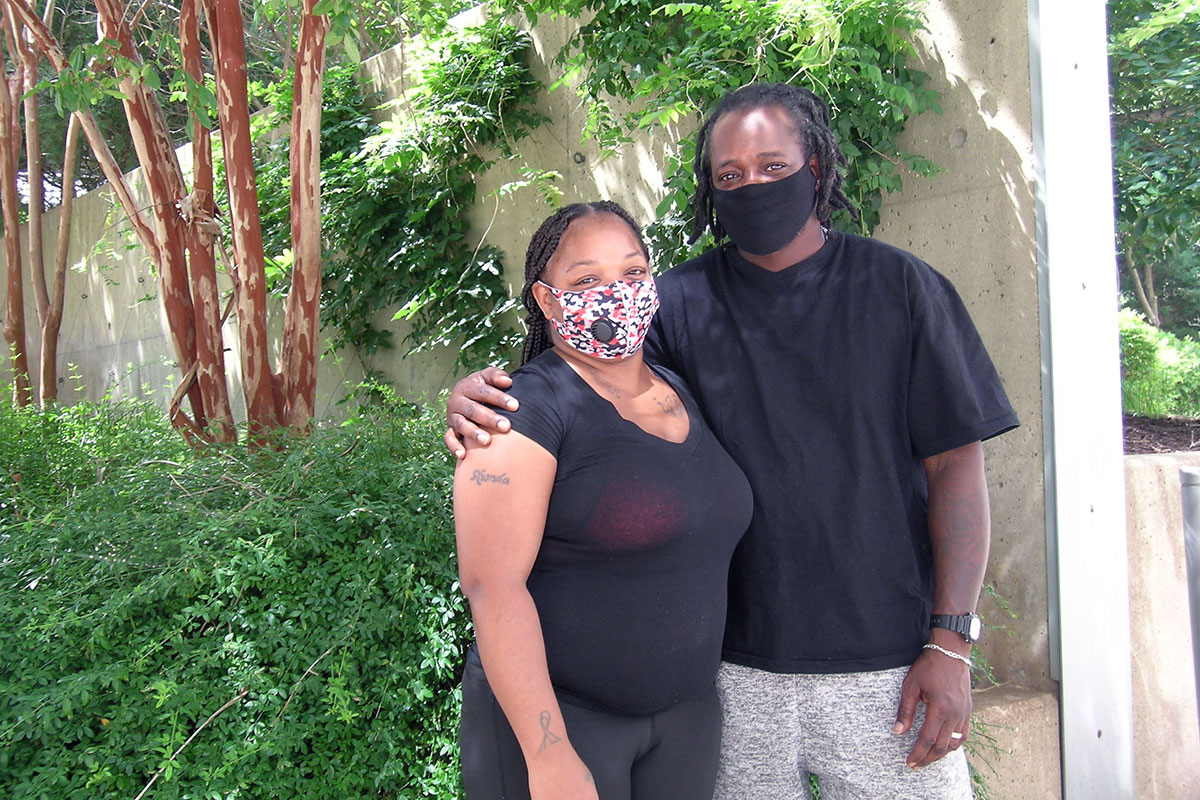The paths to homelessness are rarely straightforward, but rather have multiple twists, turns, and obstacles. More often than not, there are circumstances beyond anyone’s control, compounded by what we might simply term “bad luck.”
As part of our series on Chronicling Culture in Crisis, I interviewed a married couple—Jerome McRae and Wyketa Willis—in late August to learn more about how the coronavirus pandemic is affecting their lives and to better understand their own particular paths to homelessness.
McRae, forty-seven, and Willis, thirty-one, were both born in Washington, D.C., but led very different lives until they met three years ago. They got married and are now in secure housing, raising a family in Southeast D.C.
McRae was one of thirteen children living in Northeast and later Southeast D.C. After quarreling with one of his mother’s boyfriends, he left his home as a teen and began an odyssey of some twenty years. Sometimes he would “couch surf” with relatives, such as his father on Rhode Island Avenue or one of his sisters or brothers. Sometimes he slept on the streets, and sometimes he would stay in shelters, such as the Emery Working Men’s Shelter (now the Emery Work Bed Program) or Friendship Place. From the latter, he moved to a rooming house at Sixteenth and W Streets SE, where he met Willis, while both were out walking one day in the neighborhood.
“After that, I knew what my passion was—wanting to help people that can’t help themselves, and Southwest BID [Business Improvement District] gave me the opportunity,” McRae told me. “They opened up a position for me, Southwest BID Homeless Outreach. We go around, we get them birth certificates, IDs, and Social Security cards, and we try to get them housing.”

Willis was one of four children who moved with their mother from D.C. to Roanoke, Virginia, then back to D.C. to live with their father when she was twelve. Her path to homelessness began when she learned that her mother had also moved back to D.C. but was living on the streets.
“There was something in my heart,” Willis told me. “I just had to keep looking for my mom, because she was homeless. So I dropped out of high school, and I just kept looking for my mom. When I did find my mom—I was seventeen at that time—my father put me out.”
Willis and her mother had few options: “I was staying outside with her. We used to sleep near the McPherson Square [Metro] station. We would sleep on park benches. We would sleep in parking garages. We would sleep under bridges.”
Willis found work as a dancer in nightclubs but still could not afford permanent housing.
“I used to ride around on buses all night, and then wake up—it would be like four o’clock in the morning—and then I’d go find my mom,” she continued. “I’d sleep on a park bench all day, and she would watch my back.” After getting a job at a restaurant at Seventeenth and Pennsylvania NW, Willis finally found housing—but just then her mother suffered a partial stroke and was in a diabetic coma.
“So I enrolled myself in college for business management and was going back and forth to the school and seeing her at the hospital. I was back to sleeping on the buses, or the nurses usually allowed me to sleep in her room, because they knew what was going on.” Willis’s mother recovered, and “she finally got a stable place. I’ve been working for her ever since, until I met my husband.”

Because both McRae and Willis have personally experienced years of homelessness, they understand many of the common misunderstandings.
“People think all the homeless are the same, but they all have different stories,” Willis explained. “Some have been abused and have fled in other situations, and are afraid to go to a sheltered place or to even ask for help, because they always get looked down on. I was in that same boat and I know how it feels.”
McRae agrees, “The majority of people who are homeless, they have situations. Some are ex-military. People look down on them because of their situation. But if you sit and talk to them, the majority of them will have a story, and it’s like, ‘Whoa. Now I understand.’”
McRae continues to work with Homeless Outreach during the coronavirus pandemic but worries that he might contract the disease and take it home to his family. “That is one of my biggest fears,” he admits.
McRae is seeing fewer people living on the streets but is not sure where they have gone. “Some have gone to shelters, or you might catch them at Gallery Place or Union Station. It is like a ghost town down here now [in Southwest D.C.].”
Asked how we might help those who are experiencing homelessness, especially at this time, Willis and McRae had similar responses. “Always tell them, ‘don’t give up,’” McRae advised. “I went through the same thing, and you will be okay.”
“Just listen to them,” Willis added. “Let them know they are not alone.”

Part 1: “Like We Were a Coronavirus!” Experiencing Homelessness in the Pandemic
Part 2: “Alexander the Grate” on Homelessness Amid the Pandemic
James Deutsch is a curator at the Center for Folklife and Cultural Heritage who since the early 1980s has been studying homelessness in the United States. His publications include “City-Wide Sweeps of the Homeless,” in The SAGE Encyclopedia of Surveillance, Security, and Privacy (2018); “Homelessness,” in Global Social Issues: An Encyclopedia (2013); and “The Phenomenon of Homelessness in the United States,” in Traveling Subjects: American Journeys in Space and Time (2004).


